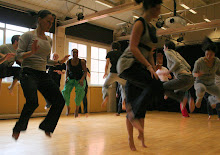1. Over the past 5 weeks we have created the opening section of our piece and also smaller sections of material. As there are a large number of us working within the company I initially thought it would prove difficult to allow everyone’s input into the work. Alison Oddey states that devised theatre “is determined and defined by a group of people who set up an initial framework or structure to explore and experiment with ideas...” Oddey (1996), p.1) Once we had decided we were to work on the opening section, we used the ‘clap’ method. This not only allows each of us to have a chance to share our ideas, but it also gives a brief insight into the character that is showing their action. This is because the action/ movements come from the characters feelings and emotions, rather than a certain feeling or emotion controlling what the character does next. Play sessions are also very useful to us as an ensemble as it allows self discovery and also helps characters develop within themselves as well as allowing us to build relationships with others. Oddey also says that “Any definition of devised theatre must include process, collaboration, multi vision and the creation of an artistic product.” Oddey (1996), p.6) I personally feel that her view on this and our current position within the company reflect each other well. Initially I thought that the company may have a problem whilst sharing our ideas as they are so diverse but the devising strategies we have decided to use work very well.
2. At the beginning of my journey I felt distanced from my character, but as the weeks go on I’m realising just how much I need to relate to her in order to be able to go on. The main thing that drives her is determination. This is due to things which have happened in the past which have caused disruption and chaos to everyday life, yet the determination is apparent as there was, and still is, a need to overcome the problems which occur. I have realised in the past week, that my character has a very hard and strong ‘outer shell’ which is why I find it difficult to let others in, although it seems there is a point where I do actually give in, as I found whilst working with Amy in the ‘train’ section. The week which we worked on that section was when my character developed the most. Dennis identifies that “Comprehension of a character must begin from an understanding of his everyday life. Its development will depend on where the character, in the piece, is heading.” Dennis (2002, p. 47). This is relevant to me as there is, and always will be a physical risk involved for my character which derives from me personally, but during that session the physical work came easily as I was aware that my character was very stubborn, but yet I found it surprising and quite emotionally draining that my character does in fact give in eventually, but I am yet to find out what causes her to let the barriers down.
3. When we were first asked to do a spinal roll then transform into our characters, I initially felt the need to act on instinct and think about it first. I then had to go back to the floor, into neutral and get into the frame of mind of my character. Whilst standing, my character tends to shift the weight from one leg to the other, which on first impression gives a casual and laid back impression. This is soon contradicted when looking at my characters gestures and movements. Her arms are either crossed, or her hands are in her pockets. Failing this she will be fiddling with the strap on her bag. This is mainly a comfort thing, as my character feels exposed and often vulnerable – although she doesn’t show that when other characters are around and interacting with her. Also, her hand is often near her face or neck. This is more of a reminder to her rather than symbolic to anyone as it helps her to focus on the problems she is faced with. Her posture is also a key feature of her physicality, but this is something which is still developing. Her spine is a fragile and vulnerable area to her and her stance and relationship to gravity is constantly changing at the moment.
Dennis, A (2002) The articulate body: the physical training of the actor: Nick Hern Books.
Keefe J, S Murray (2007) Physical theatres: a critical reader: London: Routledge.
Oddey, A (1996) Devising Theatre: a practical and theoretical handbook: London: Routledge.
http://www.jasminvardimon.com/
http://www.motionhouse.co.uk/
Marie Hartland
skip to main |
skip to sidebar
Welcome to Porto2009.
This is the begining of our journey on the road of Porto2009. And the blog will give us the opportunity as a group to reflect on the work in which we have done within the sessions. We will keep you posted regarding the process we are making along the way.....
Enjoy.
Enjoy.



No comments:
Post a Comment